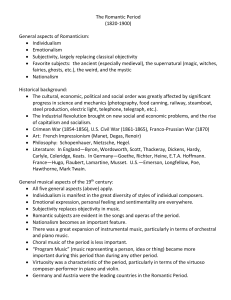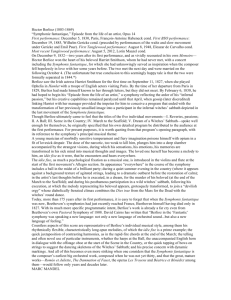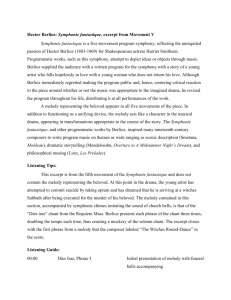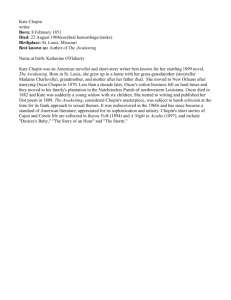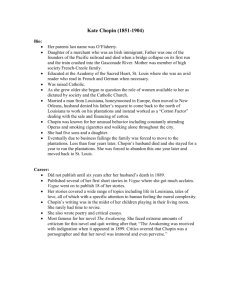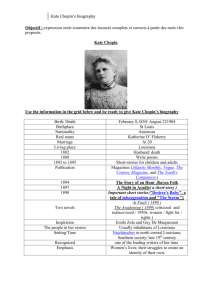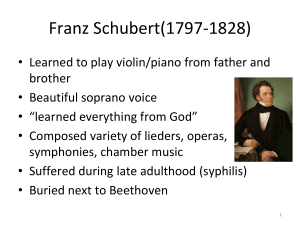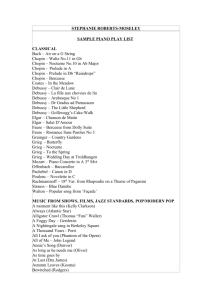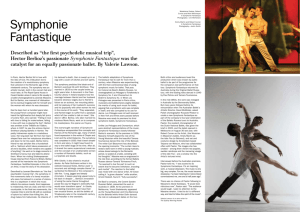exam 4 take-home
advertisement
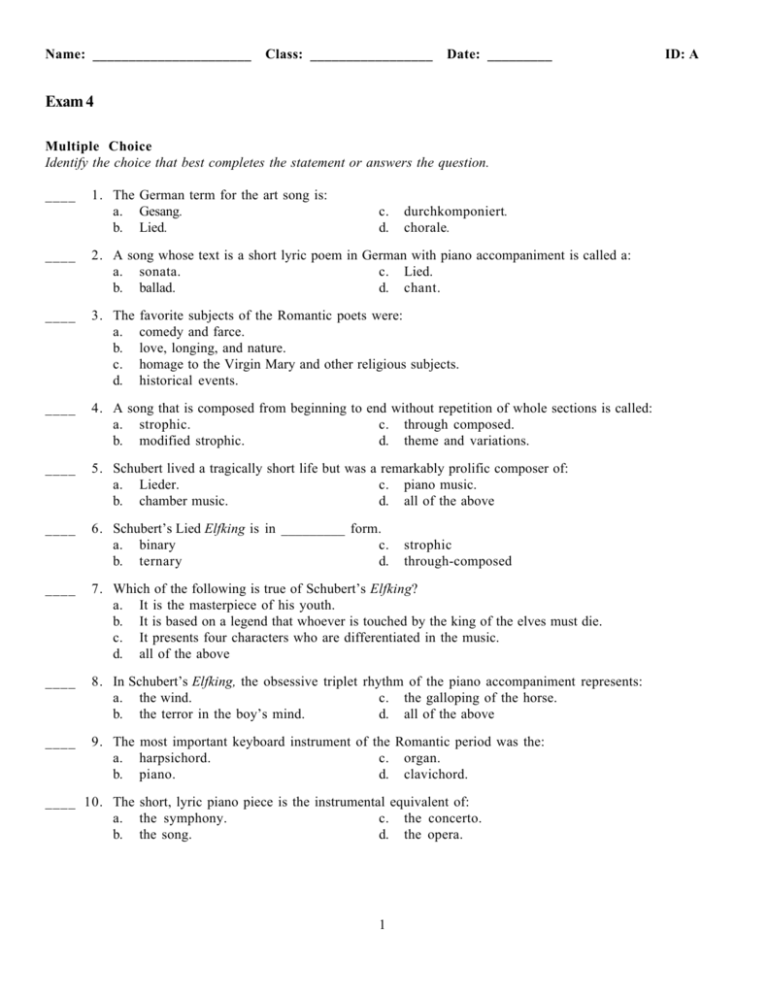
Name: ______________________ Class: _________________ Date: _________ Exam 4 Multiple Choice Identify the choice that best completes the statement or answers the question. ____ 1. The German term for the art song is: a. Gesang. b. Lied. c. d. durchkomponiert. chorale. ____ 2. A song whose text is a short lyric poem in German with piano accompaniment is called a: a. sonata. c. Lied. b. ballad. d. chant. ____ 3. The a. b. c. d. ____ 4. A song that is composed from beginning to end without repetition of whole sections is called: a. strophic. c. through composed. b. modified strophic. d. theme and variations. ____ 5. Schubert lived a tragically short life but was a remarkably prolific composer of: a. Lieder. c. piano music. b. chamber music. d. all of the above ____ 6. Schubert’s Lied Elfking is in _________ form. a. binary c. b. ternary d. favorite subjects of the Romantic poets were: comedy and farce. love, longing, and nature. homage to the Virgin Mary and other religious subjects. historical events. strophic through-composed ____ 7. Which of the following is true of Schubert’s Elfking? a. It is the masterpiece of his youth. b. It is based on a legend that whoever is touched by the king of the elves must die. c. It presents four characters who are differentiated in the music. d. all of the above ____ 8. In Schubert’s Elfking, the obsessive triplet rhythm of the piano accompaniment represents: a. the wind. c. the galloping of the horse. b. the terror in the boy’s mind. d. all of the above ____ 9. The most important keyboard instrument of the Romantic period was the: a. harpsichord. c. organ. b. piano. d. clavichord. ____ 10. The short, lyric piano piece is the instrumental equivalent of: a. the symphony. c. the concerto. b. the song. d. the opera. 1 ID: A Name: ______________________ ID: A ____ 11. Nineteenth-century composers of the short, lyric piano piece included: a. Johannes Brahms. c. Frédéric Chopin. b. Robert Schumann. d. all of the above ____ 12. Chopin is credited with creating the: a. modern piano style. b. symphonic poem. c. d. overture. Romantic symphony. ____ 13. Which nineteenth-century composer’s entire output centered around the piano? a. Brahms c. Chopin b. Liszt d. Berlioz ____ 14. Chopin spent his early years in: a. England. b. Belgium. c. d. ____ 15. Chopin spent most of his productive life in: a. Warsaw. c. b. Vienna. d. Prussia. Poland. Berlin. Paris. ____ 16. With which famous novelist did Chopin become romantically involved? a. George Sand c. Gertrude Stein b. Alexandre Dumas d. Emily Brontë ____ 17. Which of the following does NOT characterize the music of Chopin? a. rubato c. reserved emotions b. virtuosity d. lyricism ____ 18. The term rubato, associated with Chopin’s music, means that the performer should: a. play at a faster tempo. c. take liberties with the tempo. b. play at a slower tempo. d. play in strict time. ____ 19. Which composer is known as the “poet of the piano”? a. Robert Schumann c. Hector Berlioz b. Frédéric Chopin d. Johannes Brahms ____ 20. Instrumental music endowed with literary, philosophical, or pictorial associations is called: a. absolute music. c. background music. b. program music. d. pure music. ____ 21. A multimovement, programmatic work for orchestra is called a: a. symphonic poem. c. concert overture. b. program symphony. d. sonata. ____ 22. Which of the following composers is considered the first great exponent of musical Romanticism in France? a. Schubert c. Liszt b. Berlioz d. Wagner ____ 23. Hector Berlioz was born and spent most of his career in: a. Italy. c. Germany. b. France. d. Hungary. 2 Name: ______________________ ID: A ____ 24. Berlioz’s Symphonie fantastique is an example of a: a. tone poem. c. program symphony. b. symphonic poem. d. concert overture. ____ 25. Which of the following is NOT true of Berlioz’s Symphonie fantastique? a. The program deals entirely with nature. b. The program was inspired by the composer’s infatuation with an actress. c. The program presents a morbid artist in lovesick despair. d. The program is thought to be autobiographical. ____ 26. In Berlioz’s Symphonie fantastique, the idée fixe: a. symbolizes the beloved. b. recurs as required by the literary program. c. unifies the five movements, which are diverse in character and mood. d. all of the above ____ 27. In Berlioz’s Symphonie fantastique, what is the idée fixe? a. a chant from the Mass for the Dead appearing in the finale b. a shepherd song in the third movement c. the basic theme of the symphony, heard in every movement d. a theme and variations, heard in the march movement ____ 28. A one-movement piece of program music for orchestra that, through several contrasting sections, develops a poetic idea or suggests a scene or mood is called: a. a program symphony. c. a symphonic poem. b. an overture. d. incidental music. ____ 29. Which of the following composers was the first to use the term symphonic poem? a. Berlioz c. Mendelssohn b. Liszt d. Tchaikovsky ____ 30. Nationalistic composers expressed their nationalism by: a. employing songs and dances from their home countries in their works. b. borrowing exotic styles from other countries. c. writing absolute music. d. all of the above ____ 31. Which of the following was the first Bohemian composer to achieve international prominence? a. Grieg c. Musorgsky b. Smetana d. Glinka ____ 32. Smetana’s My Country is: a. a program symphony. b. an opera. ____ 33. The a. b. c. d. c. d. a symphonic poem. a set of six symphonic poems. Moldau is: Smetana’s finest achievement in orchestral music. a river that flows through Bohemia. a nationalist work. all of the above 3 Name: ______________________ ID: A ____ 34. What scene is depicted in Smetana’s symphonic poem The Moldau? a. a peasant wedding c. historic castles b. nymphs in the moonlight d. all of the above ____ 35. Musorgsky’s Pictures at an Exhibition is an example of: a. program music. c. a Lied. b. absolute music. d. a song cycle. ____ 36. The most important organizing element in absolute music is: a. form. c. programmatic images. b. thematic transformation. d. improvisation. ____ 37. By a. b. c. d. the Romantic era, concerts had moved from: the opera house to the church. the aristocratic palace to the church. the aristocratic palace to the public concert hall. the public concert hall to the aristocratic palace. ____ 38. Brahms wrote ____________ symphonies. a. four b. five c. d. nine 104 ____ 39. Brahms is often described as a(n) ____________ because of his use of forms of the Classical masters. a. traditionalist c. nationalist b. Impressionist d. Romanticist ____ 40. The earliest harbingers of modernism were artists and writers from: a. Russia. c. France. b. Spain. d. Germany. ____ 41. Impressionism: Sun Rising, the painting that sparked the Impressionist art movement, was created by: a. Auguste Renoir. c. Claude Monet. b. Edgar Degas. d. Paul Verlaine. ____ 42. Impressionism was a style of painting that was cultivated principally in: a. Paris. c. Berlin. b. London. d. Rome. ____ 43. The whole-tone scale used by Impressionist composers derives from: a. the post-Romantic music of Mahler. c. medieval church music. b. non-Western music. d. the Classical-Romantic tradition. ____ 44. Which of the following was NOT characteristic of Impressionist music? a. whole-tone scales b. parallel chords c. ninth chords d. strong accents on the first beat of each measure ____ 45. The African American dance seen at the World Exhibition of 1889 was: a. the gavotte. c. the tango. b. the cakewalk. d. the rumba. 4 Name: ______________________ ID: A ____ 46. Impressionism in music is best exemplified by the works of: a. Claude Debussy. c. Hector Berlioz. b. Gustav Mahler. d. Frédéric Chopin. ____ 47. What nationality was Claude Debussy? a. German b. French c. d. Italian Austrian ____ 48. Which of the following is NOT a composition by Debussy? a. Clair de lune b. La mer c. Boléro d. Prelude to “ The Afternoon of a Faun” ____ 49. The a. b. c. d. program of Debussy’s Prelude to “ The Afternoon of a Faun” evokes: a nationalistic folk dance. a river flowing through France. a child’s view of heaven. a landscape with a mythological creature. ____ 50. What is unusual about the opening of Debussy’s Prelude to “ The Afternoon of a Faun”? a. It opens with solo bassoon in the high register. b. It opens with a drum roll and fanfare. c. It opens with a flute solo in the velvety lower register. d. It opens with unison strings. 5
